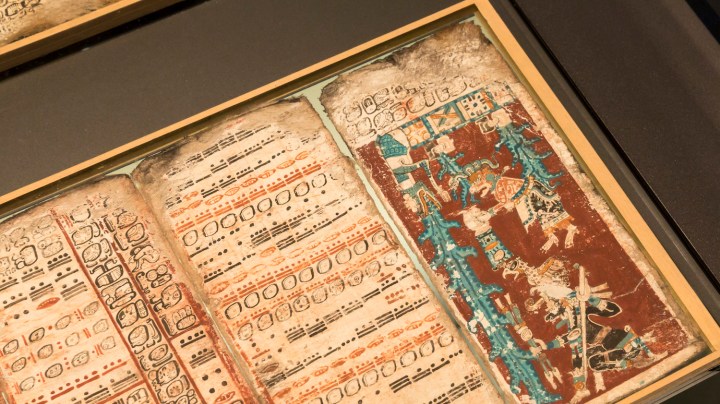Maya Codex Confirmed To Be Oldest Pre-Hispanic Document In the Americas

A sky caiman vomits water on one of the last pages of the 12th-century Dresden Codex. Photo by Joern Haufe/Getty Images
A Maya codex was just confirmed as the oldest pre-Hispanic text in existence. After 54 years, Mexico’s National Institute of History and Anthropology revealed the text is the oldest document available from pre-Hispanic times.
The calendar-style text was sold by looters more than 50 years ago, which impacted the credibility of the document for decades. The text is believe to have contained 20 pages at some point, but most were lost in a cave in Chiapas. Now, only 10 remain in the book, now known as the Mexico Maya Codex, which contains predictions and observations in syllabic glyphs. Formerly, it was called the Grolier Codex.
The book has had quite the trip since it was first discovered. In 1964, a Mexican collector bought it and, in 1971, it was exhibited at the Grolier Club in New York. By 1974, it was returned to Mexico after collector Josue Saenz brought it back. For many years, authorities doubted its authenticity because its design was simpler than other documents from the era.
The Maya Codex survived an era of genocide and erasure from Spanish conquerors, who attempted to burn all Maya artifacts around the 1500s. The book is said to have been created between 1021 and 1154 A.D. It makes sense to the National Institute of History and Anthropology for the text to be simpler than others, since it was created in a time of relative poverty. “For a long time, critics of the codex said the style wasn’t Maya and that it was ‘the ugliest’ of them in terms of figures and color,” institute researcher Sofia Martinez del Campo told NBC News.

But this announcement signifies the end of decades of debates between several Mexican researchers and a new horizon for the study of pre-Hispanic Maya culture. The codex is currently on display at the National Museum of Anthropology in Mexico City until the end of October. Get a glimpse below.